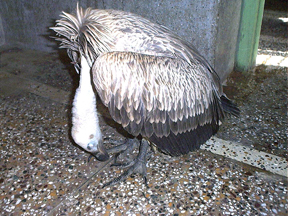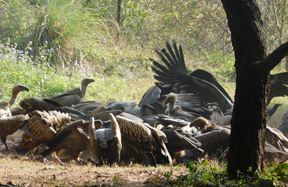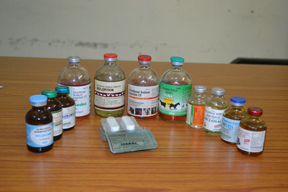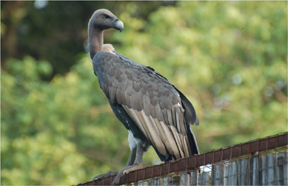Veterinarians contribute to efforts in India to protect, restore decimated populations
Sick Vulture

Photo by Yedra Feltrer
Vultures poisoned by diclofenac, like the one shown, die rapidly from kidney disease.
Painkillers used to treat livestock have inadvertently caused a devastating drop in South Asia's vulture population. Now veterinarians are part of the solution, as they assist in efforts to save several endangered species of the ecologically important scavengers from extinction.
The years-long battle remains far from won. Even as awareness of the issue grows, practitioners are identifying more drugs that are harmful to vultures, while a shortage of veterinarians in countries such as India hampers progress on breeding programs designed to lift bird numbers in the wild.
Mounting discoveries of poisoned vultures in Spain, meanwhile, are adding weight to calls for more judicious use of certain veterinary painkillers in Europe.
The drugs in question are nonsteroidal anti-inflammatory drugs (NSAIDs), a class of medicines used to treat pain and fever in humans and other animals. The NSAIDs include household names such as ibuprofen. Sensitivity to their side effects, which typically include stomach ulceration and kidney failure, can differ widely between species and the type of NSAID administered. Humans, for instance, are far more tolerant of ibuprofen than cats and dogs but still can experience side effects at high doses.
Some NSAIDs, most notably diclofenac (familiar in the U.S. as Voltaren, an over-the-counter arthritis-relief gel for people), have been found to be highly toxic for certain species of vulture. The scavengers succumb to kidney disease after ingesting residues through feasting on carcasses of animals injected with the drugs.
The stakes are high for people as well as the birds. In parts of South Asia, where the NSAIDs poisoning crisis is most pronounced, vultures play a critical role in devouring the carcasses of cows, which are revered in Hindu culture and often roam free. When they die, if their remains aren't consumed by vultures, their bodies can become health hazards.
"A group of 70 vultures can strip a cow carcass to bones in a matter of 15 to 20 minutes, so they would clean them up very precisely," said Dr. Percy Avari, a Bangalore-based veterinarian who assists in conservation efforts. "And now because the vultures are disappearing, there is more food available for dogs and rats that spread diseases like rabies, causing their numbers to explode."
A particular sensitivity to diclofenac was identified around 20 years ago in species of Gyps vulture, also known as "old-world vultures." Gyps largely are found in the South Asian countries of India, Pakistan, Nepal and Bangladesh, as well as throughout Africa. NSAID toxicity also is a problem in Africa, though not as acutely as in South Asia. Africa's endangered vultures, however, face a host of other pressures, including habitat loss, electrocution from power lines and poisoning from other sources that include pesticides and lead ammunition.
Gyps also are present in some southern and eastern European countries, predominantly Spain, Portugal and Italy. The "new-world vultures" that inhabit the Americas, including condors and turkey vultures, have a different evolutionary lineage from Gyps and have not been found to be susceptible to NSAID toxicity, though such research appears to be limited.
To date, diclofenac, which in the U.S. is labeled for veterinary use only in horses, has been identified as the worst-offending NSAID. In 2006, India banned diclofenac in veterinary medicine after it was linked to a staggering 97% to 99% drop over 15 years in the populations of certain species of vulture. Illegal use of diclofenac, however, remains a problem on the Indian subcontinent since it is still available for human use, and some farmers and uninformed veterinarians and paraprofessionals continue to administer it to cattle.
"With human drugs, almost anything can be bought over the counter here," said Chris Bowden, the Bangalore-based coordinator of an advocacy consortium called Saving Asia's Vultures from Extinction (SAVE). "So that's a problem. And now, of course, we know that some other similar drugs are lethal to vultures, too.”
In recent months and years, the list of NSAIDs found to be toxic to Gyps has grown to include aceclofenac, flunixin, ketoprofen and nimesulide, which are available to varying degrees in different countries, depending on local regulations. None is banned in India, though groups like SAVE are lobbying for them to be prohibited there.
Effective alternatives exist. Veterinarians in South Asia have for years been encouraged to use meloxicam, which also is an NSAID but isn't toxic to vultures because it has a slightly different mode of action. Furthermore, research by a team from the governmental Indian Veterinary Research Institute and collaborators, published in February, identified a second NSAID that is safe for vultures: tolfenamic acid.
A third painkiller, paracetamol, has been shown to be safe following preliminary testing at the same institute, the VIN News Service has learned. (Paracetamol is not generally classed as an NSAID because it has minimal anti-inflammatory properties). A safety declaration on paracetamol will be made official when further testing results are finalized, said Dr. A. M. Pawde, who heads the institute's Centre for Wildlife.
Pawde stressed that even drugs deemed safe could harm vultures if not used judiciously. "People can't pump animals full of these drugs at many times the recommended dose just because they've been declared safe," he said.
Testing is underway on ibuprofen, Pawde said. Other drugs that veterinarians plan to test include phenylbutazone, metamizole and piroxicam.
On the ground, some wins, some setbacks
Vultures feeding

Photo by Vibhu Prakash
Since vultures tend to congregate to feed, even a small number of livestock carcasses containing residues of certain NSAIDs can trigger a sizeable decline in populations of the scavengers.
Avari, a former assistant professor at Bombay Veterinary College who recently started a marketing job at a pharmaceutical company, has witnessed the decline in India's vulture population firsthand. He often volunteers at a rescue center during an international kite festival held annually in Ahmedabad, Gurajat, to treat birds injured by kite strings. The number of vultures he's treating has dropped, but not for good reasons.
"Every year, you'd get about 18 to 20 vultures hurt by kites," he said. "Now, we get two or three, maybe five or six, because there's less of them around."
Avari has seen with his own eyes what diclofenac can do, recalling an incident when a colleague unwittingly injected the drug directly into a vulture with an injured leg. "It passed away the next day," he said. "There was gout all over the place."
Gyps vultures have been found to be especially sensitive to the development of visceral gout following exposure to diclofenac. The condition is caused by a buildup of uric acid, which, at high levels, crystallizes and coats internal organs in a white paste.
NSAIDs are sought after because they inhibit the enzyme cyclooxygenase, also known as COX, which is associated with inflammation and pain. There are two types of cyclooxygenase — COX-1 and COX-2 — with COX-1 inhibition more likely to cause adverse effects in certain animals. So-called "selective" NSAIDs, such as meloxicam, are considered safer because they inhibit COX-2. By contrast, "nonselective" NSAIDs, such as diclofenac, inhibit both COX-1 and COX-2.
Diclofenac happens to be cheaper than meloxicam and faster-acting — properties that some veterinarians and farmers find compelling. "The beauty was that even if the cow was quite hurt, a diclofenac injection would quickly help it get up and start eating," Avari said. "The results were magnificent; you could say magical, to a certain extent."
Efforts to get veterinarians to switch to vulture-safe meloxicam were complicated by generic products containing wildly varying alkalinity levels that affected their efficacy and even caused some cows to suffer. Over time, though, the quality of generic meloxicam sold in India has improved.
Campaigners also have convinced the Indian government to ban drug manufacturers from cynically selling diclofenac for human use in "multi-dose" vials suitable for large animals. Rule enforcement, however, is patchy, laments SAVE's Bowden.
"Now, you get people who sell you a bundle of five little vials with rubber bands around it," he said. "Still, it does make it cost a little more and helps bring down the cost difference between diclofenac and meloxicam, which really has become quite trivial anyway."
Ongoing advocacy efforts include educating veterinarians and paraprofessionals about the risks of NSAIDs, many of whom are employed by the Indian government or by the country's large dairy cooperatives. With heads of cattle numbering in the hundreds of millions, India has the world's biggest cow population. The animals supply milk and clarified butter, also known as ghee, often used in sweets. Cow dung is used for fertilizer, while cow urine is considered by some to be sacred and applied topically for purification purposes. India's cows tend to be kept by villagers in little groups rather than large herds, their milk pooled by dairy cooperatives.
To help authorities assess how well advocacy efforts are going, Avari last year set up an online spreadsheet to which veterinarians could list the NSAIDs they use on cattle. He excluded diclofenac from the voluntary, non-peer-reviewed study because he didn't want to be seen as legitimizing its use. Meloxicam was selected as the most commonly used drug among the 124 veterinarians who participated, with 89.5% using it. But the usage of other NSAIDs that are toxic to vultures also was high, especially of flunixin (75.8%), nimesulide (43.5%) and ketoprofen (33.9%).
Hundreds of captive vultures poised for release
Diclofenac

Photo courtesy of the Bombay Natural History Society
India in 2006 banned veterinary use of diclofenac, pictured here in various formulations, because it is highly toxic to vultures. The drug remains available as human medicine and is used illegally to treat animals by some farmers and uninformed veterinarians and paraprofessionals.
The lingering existence of those drugs in the environment is making one man especially nervous.
Vibhu Prakash, principal scientist at the Bombay Natural History Society (BNHS), a nongovernmental organization, was the first person to alert the international scientific community to the rapid decline in India's vulture population during the 1990s.
Now, the biologist is in charge of a vulture conservation program for which there are eight breeding centers around the country. At last count, they housed around 750 vultures born in captivity and destined for the wild.
"We are set to release more vultures," Prakash said. "But the problem is that these toxic drugs are still out there."
Diclofenac residues found in vultures have declined substantially in most parts of India and are now being detected in fewer than 2% of the carcasses the BNHS samples. However, since vultures tend to congregate to feed, research has found that a carcass contamination rate below 1% is sufficient to trigger a meaningful decline in their numbers. And there are the other NSAIDs harmful to vultures to consider.
The lingering threat hasn't stopped the BNHS from releasing a few birds, and the results so far are encouraging. The first release occurred in 2020. Of eight vultures set free, five are alive, and none of the other three died from NSAID poisoning. Another 10 vultures were released in January 2021; all are still alive.
In each case, the vultures were released into so-called safe zones with a radius of 100 kilometers (62 miles) in which concentrated advocacy efforts were conducted. Prakash stresses, though, that despite their name, the zones aren't completely safe because nobody can be sure of the amount of toxicants still present.
The next batch of vultures bred in captivity is scheduled to be released in August or September.
The BNHS employs three veterinarians, who perform health checks and postmortems, among other duties, though Prakash laments practitioners can be hard to retain since they often pursue jobs in academia or private practice.
“We have an acute shortage of properly trained veterinarians in India," Prakash said. "A lot of the people administering drugs to cattle only know a little bit about them or are just cattle owners. And sometimes they administer very large doses — as much as 35 to 50 times the normal veterinary dose."
The BNHS also is struggling with a drop in government funding, hobbling its ability to purchase safe food for the vultures and surveillance equipment such as tags.
"The thing is, we are making progress, but it is slow," Prakash said.
Alarm raised for Europe and beyond
Oriental white-backed vulture

Photo courtesy of the Bombay Natural History Society
The Oriental white-backed vulture is one of four species of South Asian vulture that is critically endangered. The other three are the long-billed vulture, slender-billed vulture and red-headed vulture.
As India strives to save its vultures, there are fears that history could repeat itself elsewhere.
India's historic decision in March 2006 to ban diclofenac for veterinary use seemingly set off a domino effect. Nepal, Pakistan, Bangladesh, Cambodia, Iran and, most recently, Oman have followed suit, all in the interest of vulture conservation.
So it was with some surprise to many conservationists that almost a decade after India's ban, the European Union decided to permit veterinary use of diclofenac.
In 2015, having reviewed the threat to Europe's vultures, the EU concluded the risk was manageable, asserting that farmers in the five member states in which diclofenac was allowed — the Czech Republic, Estonia, Italy, Latvia and Spain — had more control over their cattle and could handle carcasses safely.
"Here we were attending meetings in Africa to try and stop this getting worse, but foolishly, as it turns out," SAVE's Bowden said. "We weren't doing that proactively in Europe because it seemed a no-brainer."
Spain, which has the highest concentration of vultures in Europe, authorized veterinary use of diclofenac in 2013, even though just the year before, a dead vulture with high levels of flunixin was discovered in the country. Flunixin has since been found in other dead vultures there. Last year, researchers confirmed the first known case of diclofenac poisoning in a European vulture, found dead in a nest in Catalonia, Spain, in December 2020.
Conscious that other dead birds may have gone undetected and that only a tiny percentage of carcasses need to be contaminated to trigger many vulture deaths, some scientists fear that thousands of European birds could die each year.
Among those lobbying for bans is Dr. Andrew Routh, head veterinarian at Jersey Zoo, located on the island of Jersey in the English Channel.
"Relatively speaking, we have good populations of vultures, particularly in Spain and Portugal," he said. "But we also know that 20 to 25 years ago, we had tens of millions of vultures in the Indian subcontinent, and look what happened there."
Routh accepts that cattle husbandry practices differ from country to country. At the same time, he said, cattle in Southern Europe can venture over wide ranges and die in places where carcasses aren't immediately detected. He urged veterinarians living in countries where vultures are present to consider opting for safer drugs such as meloxicam. "Every vulture, I think, is important, and every vulture death due to NSAIDs administered to cattle is avoidable," he said.
As for other continents, Routh cautions that little is known about the effects of NSAIDs on other birds, noting that studies proving their toxicity to certain species often aren't conducted until large numbers of animals die.
As a case in point, Bowden points to a study published in 2014, which found that diclofenac is toxic to steppe eagles found in South Asia. Steppe eagles are close relatives of golden eagles in the U.S.
"These drugs, NSAIDs, are useful, but they're something we need to handle with care," Routh said. "At our zoo, our go-to nonsteroidal is meloxicam because it gives us what we think is a relatively safe option, and it certainly works well."
Whether years of increased meloxicam use is helping India's vulture population remains to be seen. Prakash, who still is counting the birds, is due to release his next update on vulture numbers in three to four months. In recent years, he said, the population has stabilized. But for the extinction threat to ease, he said, it needs to rise.
"One released pair of vultures that we found, they made a nest, they made an egg, but unfortunately the nest was disturbed by monkeys," Prakash said.
"And one other released bird, it paired with a wild bird. So hopefully next year, we will have chicks. That would be really satisfying."